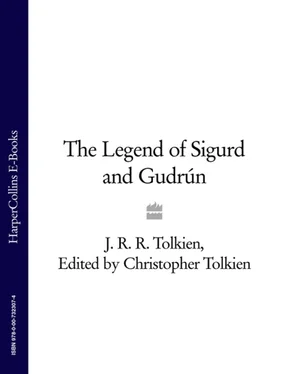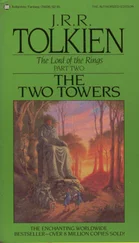J. Tolkien - The Legend of Sigurd and Gudrún
Здесь есть возможность читать онлайн «J. Tolkien - The Legend of Sigurd and Gudrún» — ознакомительный отрывок электронной книги совершенно бесплатно, а после прочтения отрывка купить полную версию. В некоторых случаях можно слушать аудио, скачать через торрент в формате fb2 и присутствует краткое содержание. Жанр: Старинная литература, на английском языке. Описание произведения, (предисловие) а так же отзывы посетителей доступны на портале библиотеки ЛибКат.
- Название:The Legend of Sigurd and Gudrún
- Автор:
- Жанр:
- Год:неизвестен
- ISBN:нет данных
- Рейтинг книги:5 / 5. Голосов: 1
-
Избранное:Добавить в избранное
- Отзывы:
-
Ваша оценка:
- 100
- 1
- 2
- 3
- 4
- 5
The Legend of Sigurd and Gudrún: краткое содержание, описание и аннотация
Предлагаем к чтению аннотацию, описание, краткое содержание или предисловие (зависит от того, что написал сам автор книги «The Legend of Sigurd and Gudrún»). Если вы не нашли необходимую информацию о книге — напишите в комментариях, мы постараемся отыскать её.
The Legend of Sigurd and Gudrún — читать онлайн ознакомительный отрывок
Ниже представлен текст книги, разбитый по страницам. Система сохранения места последней прочитанной страницы, позволяет с удобством читать онлайн бесплатно книгу «The Legend of Sigurd and Gudrún», без необходимости каждый раз заново искать на чём Вы остановились. Поставьте закладку, и сможете в любой момент перейти на страницу, на которой закончили чтение.
Интервал:
Закладка:
An important element in the story as told in the Saga is entirely absent from this section of the Lay. After the making of the sword Gram and the acquisition of the horse Grani, Sigurd declared to Regin that he would not attack Fáfnir until he had avenged his father; and setting out with a great host and fleet provided by King Hjálprek he achieved this in a bloody battle in which he slew King Lyngvi. But a form of the story of Sigurd’s revenge appears in the Lay at a later point in the narrative (VII.24–29).
14 Gnitaheiði: this name in Old Norse is Gnitaheiðr , of which the second element is Old Norse heiðr ‘heath’, and it is variously anglicized as ‘Gnitaheid’, ‘Gnitaheith’, or ‘Gnitaheath’. In my father’s poems it appears several times but always in the combination ‘on Gnitaheiði’. This may be a retention of the dative case, or it may be a use of the modern Icelandic form of the word, which is heiði.
17–18 It was Sigurd who broke the two swords by striking them on an anvil; whereupon, according to the Saga, he went to his mother and asked whether it were true that Sigmund had entrusted to her the fragments of his sword, and she gave them to him. On the name Gram ( Gramr ) see the note to IV.13.
20 Both Snorri Sturluson and the Saga know of Sigurd’s testing of the sharpness of Gram by its cutting of the tuft of wool when it drifted in the water onto the sword’s edge; but only in the Lay is the river called the Rhine ( Rín in Norse).
‘sheer’: clear.
21 ‘Now rede me’: Now give me counsel.
22–24 Only in the Saga is this story found of how Sigurd came to possess his grey horse Grani (very frequently named in poems of the Edda). The old man is once again Ódin (with the description here compare II.12, III.12, IV.8).
The name Busiltarn is derived from the Saga; the Norse form is Busiltjörn , which was the form first written by my father in the manuscript of the Lay, later corrected in pencil. The English word tarn , a small lake, is derived from the Norse word; but in the Saga the Busiltarn is said to be a river, as it clearly is also in the Lay.
Sleipnir was the name of Ódin’s eight-legged horse.
25 Gand: Regin’s horse is not named elsewhere, but this must be the Old Norse word gandr (contained in ‘Gandalf’). Its original or primary meaning is uncertain, but it has reference to sorcery and magic, both beings and things, and especially to the staff used in witchcraft; it is also use of wolves. The word gandreið is used of the witches’ nocturnal ride.
In a lecture on the text of Fáfnismál my father remarked on the huge height of the cliff from which Fáfnir drank as a good detail in the Saga absent from the poem, since Sigurd thus ‘first got a notion of what he was in for.’
26 ‘long there lurked he’: i.e. Sigurd. In the prose preamble to Fáfnismál in the Codex Regius, as also in the Saga and in Snorri Sturluson’s brief account, Sigurd dug a pit in the path which the dragon took when he crawled to the water (the ‘hollow’ of stanzas 26–27, 29, which is not said to have been made by Sigurd); in the Saga an old man (Ódin) came to Sigurd while he was digging it and advised him to dig other trenches to carry off the dragon’s blood. On this matter my father noted in a lecture:
Ódin and his advice, however, do not appear very intelligible, and the intrusion of Ódin has perhaps been imitated from other places (e.g. the choosing of Grani). The several pits do not seem of much use, for in any case Sigurd has got to be in one , and it is only in the one in which he is (immediately under the wound) that the blood is likely to pour down. The Saga version is due to harping on Ódin, and to an appreciation that the inherited plot did not paint Sigurd’s dragon-slaying (which is later referred to as his great title to fame) in the best light. It could not be altered in manner, and therefore the dragon and his poisonousness must be magnified; but it is not successfully done.
His view was that the original significance of the pit was to enable Sigurd to escape the blast of flame which passed over his head (cf. 27, lines 1–3).
30 In Fáfnismál , repeated in the Saga, Sigurd, in answer to Fáfnir’s question, replies that he is called göfugt dýr, that is ‘noble beast’; and a prose note at this point in the Codex Regius explains that ‘Sigurd concealed his name, because it was believed in ancient times that the word of a dying man might have great power if he cursed his foe by his name.’ My father observed that this note was ‘doubtless perfectly correct for the original writer of the poem, whose audience were probably sufficiently of the “ancient times” not to need the explanation!’ He said also that ‘the mysterious words göfugt dýr are probably meant to be obscure, even nonsensical’, though they might be ‘a riddling way of saying “man”.’
33 ‘glamoured’: enchanted.
34 Sigurd’s words in this stanza refer to the œgishjálmr ‘Helm of Terror’ which Heidmar possessed and which Fáfnir took to wear himself: see p.205, and stanza 14. At the words ‘hell now seize him!’ Fáfnir died.
36–41 My father declared the ‘undermeaning’ of Regin’s ‘dark words’ in his preamble to this section of the Lay; and in notes for a lecture (written in pencil at great speed and now not entirely legible) he discussed in detail the relationship in this episode between the Saga and Fáfnismál, seeking to determine not only how the writer of the Saga compressed and modified the verses but why he did so. I give here, with some slight editing, a part of this discussion, since it well illustrates his critical treatment of such problems in the Edda.
He begins with a summary of the dialogue of Regin and Sigurd after the death of Fáfnir in the Saga (I give references to the stanzas and lines of the Lay in brackets).
After the death of Fáfnir Regin came to Sigurd and said: ‘You have won a great victory: your glory from it will be eternal’ [35, 1–4]. Then Regin is suddenly or affects to be suddenly stricken with disquiet – ‘he looks upon the ground for a long while’ and says with great emotion ‘it is my brother you have killed and I cannot be accounted innocent of this’ [36, 5–8]. Sigurd dries his sword on the grass, and simply replies ‘you were a long way off at the time when I tested the sword’ (implying therefore ‘innocent enough!’) [37, 1–4].
Regin counters with the fact that he made the sword [37, 5]; Sigurd counters with ‘brave heart is better than sharp sword in battle’ [38, 3–4].
Regin does not rebut this, but repeats again ‘with great emotion’ almost his exact words ‘You slew my brother, &c.’ Then Regin cut out the dragon’s heart, drank the dragon’s blood, and asked Sigurd as a sole boon (no sort of reason for which is given) to roast the heart for him.
The repetition by Regin of the words ‘You killed my brother and I can hardly be accounted innocent’ is not a feature of Fáfnismál. Does it serve an artistic purpose – or is it just accidental, due to some confusion in the saga-writer’s source, or in the handing down of the saga? It is probably intentional, and perhaps not bad. The saga-writer has constructed a picture of Regin, already plotting Sigurd’s removal, and trying as it were to justify himself to himself. Scornfully relieved of any share of responsibility by Sigurd, he contents himself with mere repetition – he adheres to his remorse, and to his ‘You slew my brother’ ( i.e. his vengeance).
After such words Sigurd should have needed no igður [the birds whose voices he could understand, see 41, 8 and 43, 1–3]. That the brother of one you had slain was unsafe was learnt almost at the mother’s knee, certainly on the father’s lap, in Scandinavia – especially when he went out of his way to point it out to you.
Читать дальшеИнтервал:
Закладка:
Похожие книги на «The Legend of Sigurd and Gudrún»
Представляем Вашему вниманию похожие книги на «The Legend of Sigurd and Gudrún» списком для выбора. Мы отобрали схожую по названию и смыслу литературу в надежде предоставить читателям больше вариантов отыскать новые, интересные, ещё непрочитанные произведения.
Обсуждение, отзывы о книге «The Legend of Sigurd and Gudrún» и просто собственные мнения читателей. Оставьте ваши комментарии, напишите, что Вы думаете о произведении, его смысле или главных героях. Укажите что конкретно понравилось, а что нет, и почему Вы так считаете.












